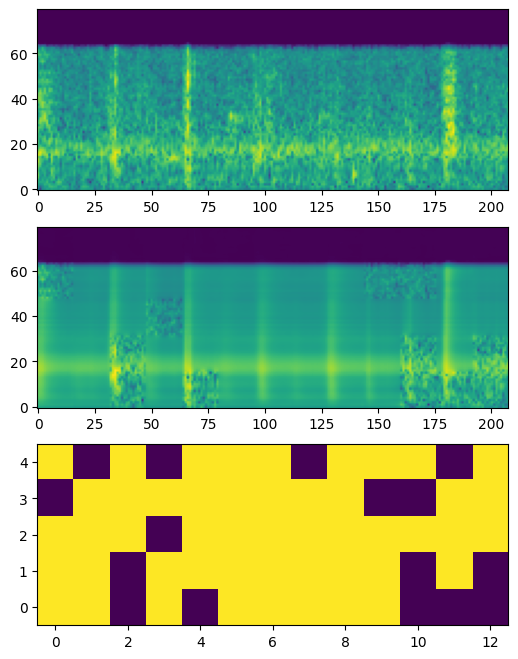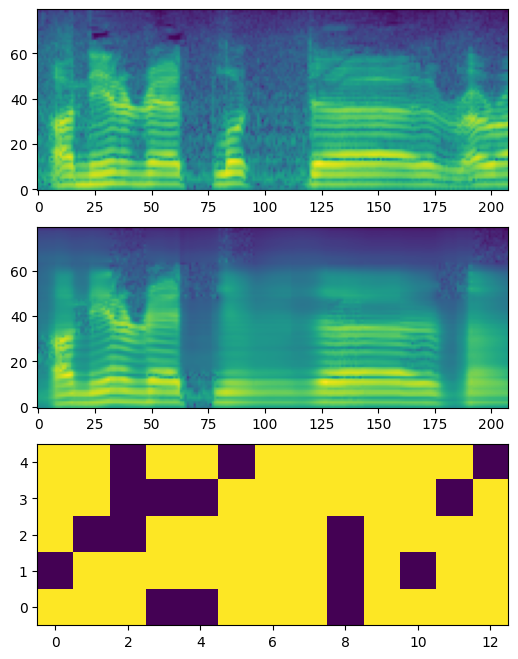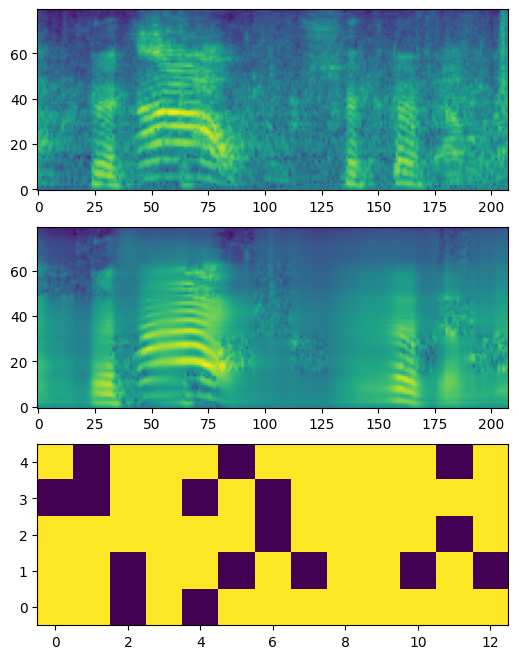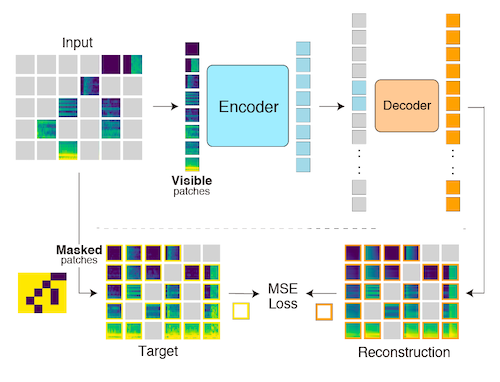Masked Spectrogram Modeling using Masked Autoencoders for Learning General-purpose Audio Representation
This is a demo implementation of Masked Spectrogram Modeling using Masked Autoencoders (MSM-MAE), a self-supervised learning method for general-purpose audio representation, includes:
- Training code that can pre-train models with arbitrary audio files.
- Evaluation code to test models under two benchmarks, HEAR 2021 and EVAR.
- Visualization examples and a notebook.
- Pre-trained weights.
If you find MSM-MAE useful in your research, please use the following BibTeX entry for citation.
@article{niizumi2022masked,
title = {Masked Spectrogram Modeling using Masked Autoencoders for Learning General-purpose Audio Representation},
author = {Daisuke Niizumi and Daiki Takeuchi and Yasunori Ohishi and Noboru Harada and Kunio Kashino},
journal = {arXiv:2204.12260},
year = {2022},
eprint = {2204.12260},
url = {https://arxiv.org/abs/2204.12260},
archivePrefix = {arXiv},
primaryClass = {eess.AS}
}The repository relies on the codes from facebookresearch/mae, and we patch our changes on these files.
- Download external source files from facebookresearch/mae, and apply a patches.
curl -o util/lars.py https://raw.githubusercontent.com/facebookresearch/mae/6a2ba402291005b003a70e99f7c87d1a2c376b0d/util/lars.py
curl -o util/lr_decay.py https://raw.githubusercontent.com/facebookresearch/mae/6a2ba402291005b003a70e99f7c87d1a2c376b0d/util/lr_decay.py
curl -o util/lr_sched.py https://raw.githubusercontent.com/facebookresearch/mae/6a2ba402291005b003a70e99f7c87d1a2c376b0d/util/lr_sched.py
curl -o util/misc.py https://raw.githubusercontent.com/facebookresearch/mae/6a2ba402291005b003a70e99f7c87d1a2c376b0d/util/misc.py
curl -o util/pos_embed.py https://raw.githubusercontent.com/facebookresearch/mae/6a2ba402291005b003a70e99f7c87d1a2c376b0d/util/pos_embed.py
curl -o main_pretrain.py https://raw.githubusercontent.com/facebookresearch/mae/6a2ba402291005b003a70e99f7c87d1a2c376b0d/main_pretrain.py
curl -o msm_mae/engine_pretrain.py https://raw.githubusercontent.com/facebookresearch/mae/6a2ba402291005b003a70e99f7c87d1a2c376b0d/engine_pretrain.py
curl -o msm_mae/models_mae.py https://raw.githubusercontent.com/facebookresearch/mae/6a2ba402291005b003a70e99f7c87d1a2c376b0d/models_mae.py
cd util
patch -p1 < patch_util.diff
cd ../msm_mae
patch -p1 < patch_msm_mae.diff
cd ..
patch -p1 < patch_main.diff- If you need a clean environment, the following anaconda example creates a new environment named
ar:
conda create -n ar python==3.8
conda activate ar- Install external modules listed on requirements.txt.
We evaluate our models on our paper using hear-eval-kit from on HEAR 2021 NeurIPS Challenge as follows.
NOTE: The folder hear has all the files we need to evaluate models on hear-eval-kit.
-
Install hear-eval-kit as follows:
pip install heareval
-
Download your copy of downstream dataset for 16 kHz. See HEAR NeurIPS 2021 Datasets@zenodo for the detail.
-
To evaluate our models, we need a local package which loads and runs our models. The followings shows an example for a model named
80x208p16x16_mymodel.cd hear/hear_msm cp sample.py 80x208p16x16_mymodel.py ** Edit the 80x208p16x16_mymodel.py here, so that the value of `model_path` points to your model with an absolute path. ** cd .. pip install -e .
-
We are on the folder
hear. Run the hear-eval-kit with your pre-trained model.python -m heareval.embeddings.runner hear_msm.80x208p16x16_mymodel --tasks-dir /your_copy/hear/tasks CUBLAS_WORKSPACE_CONFIG=:4096:8 python -m heareval.predictions.runner embeddings/hear_msm.80x208p16x16_mymodel/*
EVAR is an evaluation package for audio representations used by our research papers such as BYOL-A and Composing General Audio Representation by Fusing Multilayer Features of a Pre-trained Model. It supports the following downstream tasks: ESC-50, US8K, FSD50K, SPCV1/V2, VoxForge, VoxCeleb1, CREMA-D, GTZAN, NSynth instrument family, Pitch Audio Dataset (Surge synthesizer).
The following steps setup MSM-MAE on the EVAR.
-
Clone EVAR repository and prepare basic items.
git clone https://github.com/nttcslab/eval-audio-repr.git evar cd evar curl https://raw.githubusercontent.com/daisukelab/general-learning/master/MLP/torch_mlp_clf2.py -o evar/utils/torch_mlp_clf2.py curl https://raw.githubusercontent.com/daisukelab/sound-clf-pytorch/master/for_evar/sampler.py -o evar/sampler.py curl https://raw.githubusercontent.com/daisukelab/sound-clf-pytorch/master/for_evar/cnn14_decoupled.py -o evar/cnn14_decoupled.py cd ..
-
Install MSM-MAE files on the cloned
evarfolder.ln -s ../../to_evar/ar_msm_mae.py evar/evar ln -s ../../to_evar/msm_mae.yaml evar/config cd evar sed 's/import evar\.ar_byola/import evar\.ar_byola, evar\.ar_msm_mae/' -i lineareval.py cd ..
-
Setup downstream task datasets according to Preparing-datasets.md. The following is an example for setting up CREMA-D dataset.
cd evar python evar/utils/download_cremad.py downloads/cremad python prepare_wav.py downloads/cremad work/16k/cremad 16000 cd ..
Once setup is complete, you can evaluate your models as follows.
-
For evaluating a model with an absolute path
/your/path/to/model.pth.cd evar python lineareval.py config/msm_mae.yaml cremad weight_file=/your/path/to/model.pth -
If you want to save GPU memory, set a fewer batch size as follows. This example sets it as 16.
cd evar python lineareval.py config/msm_mae.yaml cremad batch_size=16,weight_file=/your/path/to/model.pth
First, you need to prepare pre-training data samples; then, you can pre-train your model. The following is an example to pre-train a model on FSD50K dataset.
-
Preprocess .wav files into log-mel spectrogram .npy files. The following converts from a source folder
/your/local/fsd50k/FSD50K.dev_audioto a new folderlms_fsd50kdev.python wav_to_lms.py /your/local/fsd50k/FSD50K.dev_audio lms_fsd50kdev
-
Create a CSV file which is used as a list of pre-training samples containing a single column
file_name. The following example createstrainingfiles.csv.echo file_name > trainingfiles.csv (cd lms_fsd50kdev && find . -name "*.npy") >> trainingfiles.csv
-
Make some copies of samples for visualization. The following example makes 3 symbolic links. All the samples under the folder
vis_sampleswill be used to visualize reconstruction results of a checkpoint during training.mkdir -p lms_fsd50kdev/vis_samples ln -s ../1240.npy lms_fsd50kdev/vis_samples/1240.npy ln -s ../106237.npy lms_fsd50kdev/vis_samples/106237.npy ln -s ../119949.npy lms_fsd50kdev/vis_samples/119949.npy
-
Once your data is ready, start pre-training as follows.
python main_pretrain.py 80x208p16x16_your_test --input_size 80x208 --data_path lms_fsd50kdev --dataset trainingfiles --model=mae_vit_base_patch16x16
The training loop creates a folder called the run folder to store artifacts of your training run, such as a log, visualizations, and checkpoints.
In the example above, the 80x208p16x16_your_test is the run folder name which has a format below:
<input_size>p<patch_size>_<your_free_string>
- input_size: Two integers concatenated with `x`.
- patch_size: Two integers concatenated with `x`.
- your_free_string: Optional.
NOTE: When a model is evaluated by EVAR or hear-eval-kit, the input and patch size parameters written in the run name are used.
The training loop takes two actions for evaluating checkpoints during training: visualization and calling an external command quick_eval.sh (EVAR by default).
-
While training,
main_pretrain.pywill call a script namedquick_eval.shfor every 20 epochs by default. You can editquick_eval.shfor your purpose. -
The training loop also visualizes reconstruction results using checkpoints. You can find them under the sub-folder of the run folder, such as
80x208p16x16_tttt/19. The folder contains raw results in .npy and image files in .png as the following examples.


👉 An example notebook is available. 👈
You can try visualizations of reconstruction results as well as attention maps.
- Download
AudioSetWav16k_examples.zipthat contains example wave samples from the releases and unzip the zip file in themiscfolder beforehand.
A reconstruction examples:
An attention map examples:
Three pre-trained weights are published on the releases, and the followings are their EVAR task results:
| weight | esc50 | us8k | spcv2 | vc1 | voxforge | cremad | gtzan | nsynth | surge |
|---|---|---|---|---|---|---|---|---|---|
| 80x512p16x16_paper | 89.1% | 84.3% | 93.1% | 56.1% | 97.5% | 70.1% | 79.3% | 76.9% | 37.5% |
| 80x512p16x16_0425 | 88.9% | 84.0% | 92.4% | 56.5% | 96.8% | 67.6% | 81.4% | 76.1% | 37.4% |
| 80x208p16x16_0422 | 87.1% | 82.2% | 91.1% | 49.7% | 95.6% | 66.9% | 75.9% | 76.5% | 37.8% |
- 80x512p16x16_paper: This weight is the pre-trained weight used to calculate the numbers in the paper, trained on our old unpolished code. Cannot be used for visualizations due to a minor difference in the decoder structure.
- 80x512p16x16_0425: This weight is a pre-trained weight that is trained with the current code to check reproducibility.
- 80x208p16x16_0422: This weight is a pre-trained weight that is trained with the current code to check reproducibility.
FYI: You can check a notebook that summarizes EVAR task results.
Our ViT network implementation has three minor differences from the original MAE implementation, due to historical reason. (We have already been testing based on pengzhiliang/MAE-pytorch in late 2021, before the MAE implementation became available.)
- Our implementation follows BEiT, where the k bias is always zero in the Attention calculation. Though it is explained to be equivalent in terms of calculation results, we keep this implementation in our network for better reproducibility.
[CLS]token is removable by the option--no_cls_token.- The decoder uses 1d positional embedding. You can switch to the 2d version by the option
--dec_pos_2d.
See LICENSE for details.
- Our code is based on the MAE PyTorch/GPU re-implementation of the paper Masked Autoencoders Are Scalable Vision Learners.
- We also refer to another implementation of MAE, pengzhiliang/MAE-pytorch.
- We use nnAudio (KinWaiCheuk/nnAudio) for converting raw audio into log-mel spectrogram.
We appreciate these publicly available implementations and all the modules our experiments heavily depend on!
- MAE: Kaiming He, Xinlei Chen, Saining Xie, Yanghao Li, Piotr Dollár, and Ross Girshick "Masked Autoencoders Are Scalable Vision Learners," 2021.
- MSM-MAE: Daisuke Niizumi, Daiki Takeuchi, Yasunori Ohishi, Noboru Harada, and Kunio Kashino "Masked Spectrogram Modeling using Masked Autoencoders for Learning General-purpose Audio Representation," 2022.
- BEiT: Hangbo Bao, Li Dong, and Furu Wei "BEiT: BERT Pre-Training of Image Transformers," 2021.
- HEAR 2021: Joseph Turian, Jordie Shier, Humair Raj Khan, Bhiksha Raj, Björn W. Schuller, Christian J. Steinmetz, Colin Malloy, George Tzanetakis, Gissel Velarde, Kirk McNally, Max Henry, Nicolas Pinto, Camille Noufi, Christian Clough, Dorien Herremans, Eduardo Fonseca, Jesse Engel, Justin Salamon, Philippe Esling, Pranay Manocha, Shinji Watanabe, Zeyu Jin, and Yonatan Bisk "HEAR 2021: Holistic Evaluation of Audio Representations," 2022.
- FSD50K: Eduardo Fonseca and Xavier Favory and Jordi Pons and Frederic Font and Xavier Serra, “FSD50K: an Open Dataset of Human-Labeled Sound Events,” 2020.


